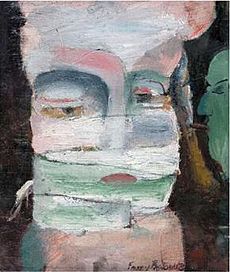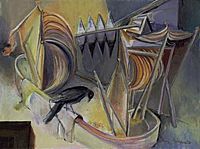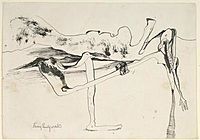Emmy Bridgwater facts for kids
Emma Frith Bridgwater (born November 10, 1906 – died March 13, 1999), known as Emmy Bridgwater, was an English artist and poet. She was part of the Surrealist art movement, which focused on dreams and the imagination.
Emmy lived in both Birmingham and London. She was an important member of the Birmingham Surrealists and the London-based British Surrealist Group. She helped connect the surrealist artists in both cities. A professor named Michel Remy, who wrote a book about Surrealism in Britain, said her influence was as important as Dalí's was for French surrealists.
Contents
Emmy Bridgwater's Life Story
Emmy Bridgwater was born in Edgbaston, a nice area in Birmingham. She was the third daughter of a chartered accountant (someone who manages money for businesses) and a Methodist (a type of Christian). From a young age, she loved painting and drawing. She studied art at the Birmingham School of Art for three years starting in 1922. Later, she worked as a secretary to pay for more art studies in Oxford.
It was sometimes hard for Emmy to build her art career because of where she lived, how much money she had, and her family background. She didn't have much contact with the London Surrealist Group. Her father couldn't give her much money, so she could only go to the Grosvenor School of Modern Art sometimes. Because she didn't earn much, Emmy had to work as a secretary while also being an artist. She couldn't even travel to Paris, a big art city, until after World War II.
Emmy's art changed a lot after she visited the London International Surrealist Exhibition in 1936. There, she met Conroy Maddox, John Melville, and Robert Melville, who were key artists in the Birmingham Surrealists. After this, her artwork started to explore the more mysterious and sometimes scary parts of the subconscious mind. She often used "automatist" techniques, which means drawing or painting without thinking too much, letting her hand move freely to express her inner thoughts.
She studied in London at the Grosvenor School of Modern Art in 1936 and 1937, but she still kept her home in Birmingham. She showed her art as part of the Birmingham Group throughout the late 1930s. She also showed her work at the London Gallery after Robert Melville introduced her to its owner, E. L. T. Mesens.
In early 1940, she officially joined the British Surrealist Group. She went to their meetings for about ten years. She became close friends with Edith Rimmington and had a short but important relationship with Toni del Renzio. Emmy's art was featured in many international surrealist magazines, including del Renzio's Arson: an ardent review. She had her first solo art show at Jack Bilbo's Modern Gallery in 1942. In 1947, André Breton, a famous surrealist, chose Emmy as one of six English artists to show their work at a big international surrealist exhibition in Paris. This was the last major international show for the surrealist group.
However, by the late 1940s, Emmy had to spend more and more time looking after her elderly mother and her sister, who had a disability. In 1953, she moved to Stratford-upon-Avon to care for them full-time. This meant she mostly stopped her art career.
In the 1970s, Emmy started making art again, mostly using collage (making pictures by sticking different materials onto a surface). Her earlier works were shown in many surrealist exhibitions over the next few decades. She stopped working in the mid-1980s and passed away in Solihull in 1999.
Emmy Bridgwater's Artworks
In the 1930s and 1940s, Emmy Bridgwater mostly created paintings and drawings using pen and ink. She is known in the surrealist movement for her automatist style. Her art often featured images like birds, eggs, leaves, fruit, and wavy, flowing lines. These were often shown in a dreamlike setting with a touch of "surrealist dark humor and strong feelings." From the 1970s onwards, she also made collages. While Emmy is best known for her paintings, collages, and drawings, she was also a poet. In 1946, she contributed to Free Unions Libres, a book of writings by French and English surrealists.
What Critics Said About Her Work
Critics were deeply moved by Emmy Bridgwater's art. Toni del Renzio wrote that her paintings weren't just seen, but "heard their cries" and made viewers feel strong emotions. He said they could make you feel things you didn't expect.
Robert Melville said Emmy's paintings showed "sad, half-seen 'presences'" that the artist met on a journey through good and evil. He felt that even though her art was dreamlike, it was also very real, showing "phantasmal hopes and murky desires."
Her obituary (a notice about someone's death) in The Independent newspaper said that her paintings showed her ability to enter her own dream world. She could turn these visions into bold, honest, and emotional landscapes that often touched the deepest parts of your mind. She used a limited range of colors and painted thickly, bringing together unrelated objects to fill empty spaces, giving her paintings a unique story.
Exhibitions of Her Art
- 1937 - The Birmingham Group, Lucy Wertheim Gallery, London
- 1938 - The Birmingham Group, Birmingham Museum and Art Gallery, Birmingham
- 193? - London Gallery, London
- 1939 - As We See Ourselves, Chapman Galleries, Birmingham
- 1942 - Emmy Bridgwater (Solo Exhibition), Modern Gallery, London
- 1947 - Coventry Art Circle Exhibition, Coventry
- 1947 - Exposition Internationale du Surrealisme, Galerie Maeght, Paris
- 1948 - Coventry Art Circle Exhibition, Coventry
- 1949 - Birmingham Artists Committee Invitation Exhibition, Royal Birmingham Society of Artists, Birmingham
- 1951 - Coventry Art Circle Exhibition, Coventry
- 1971 - Britain's Contribution to Surrealism of the 30s and 40s, Hamet Gallery, London
- 1982 - Peinture Surrealiste en Angleterre 1930-1960: Les Enfants d'Alice, Galerie 1900-2000, Paris
- 1985 - A Salute to British Surrealism 1930-1950, The Minories, Colchester; Blond Fine Art, London and Ferens Art Gallery, Hull
- 1985 - British Woman Surrealists, Blond Fine Art, London
- 1986 - Surrealism in England 1936 and after, Herbert Read Gallery, Canterbury
- 1986 - Contrariwise, Surrealism in Britain 1930-1936, Glynn Vivian Art Gallery, Swansea
- 1986 - Surrealism in Britain in the Thirties: Angels of Anarchy and Machines for Making Clouds, Leeds City Art Gallery, Leeds
- 1987 - Surrealismi, Retretti Art Centre, Suomi, Finland
- 1988 - I Surrealisti, Palazzo Reale, Milan, Italy
- 1989 - Die Surrealisten, Schirn Kunsthalle, Frankfurt, Germany
- 1989 - British Surrealism, Blond Fine Art, London
- 1990 - Emmy Bridgwater, Blond Fine Art, London
- 1991 - The Birmingham Surrealist Group, John Bonham Murray Feely Fine Art, London
- 1992 - Ten Decades - Ten Women Artists born 1897-1906, Norwich Gallery
- 1992 - The Foundations of Behaviour, John Bonham Murray Feely Fine Art, London
- 1995 - Real Surreal: British and European Surrealism, Wolverhampton Art Gallery
- 1996 - Emmy Bridgwater/Conroy Maddox: The Last Surrealists, Blond Fine Art, London
- 1996 - The Inner Eye, National Touring Exhibition
Remembering Emmy Bridgwater
A special blue plaque was put up to honor Emmy Bridgwater. It was first shown at the Birmingham Museum and Art Gallery by the Birmingham Civic Society. Then, in August 2019, it was placed on her birthplace and former home in Lee Crescent, Edgbaston.




